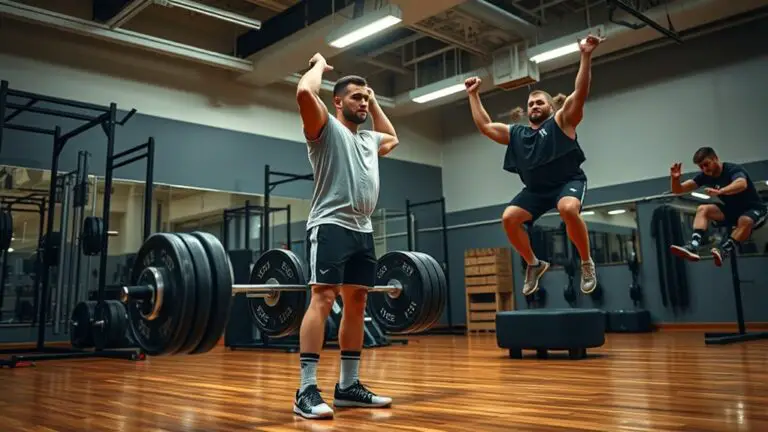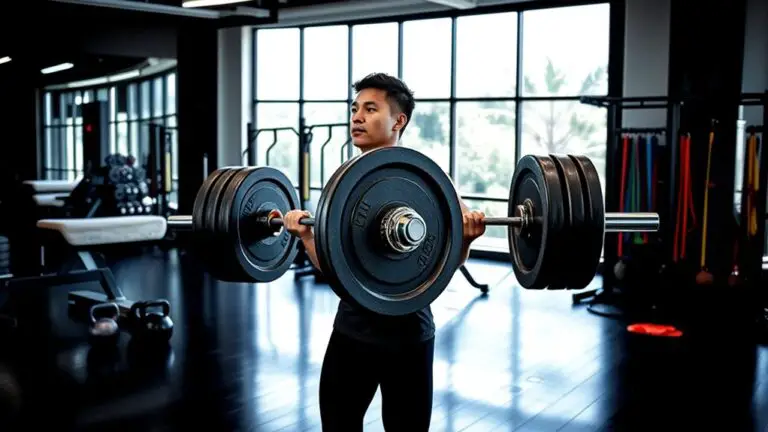How to Train Like a Boxer in the Gym

To train like a boxer in the gym, mix strength training and cardio while focusing on essential boxing techniques. Start with basic punching drills and footwork exercises. Incorporate agility drills and jump rope for cardio conditioning. Don’t skip warm-up routines to prevent injury. Shift between strength-building exercises like squats and push-ups to enhance power. Remember to prioritize recovery and listen to your body. Keep exploring, and you’ll discover more effective methods for your boxing journey.
The Benefits of Boxing Training for Fitness

When you immerse yourself in boxing training, you’re not just stepping into the ring; you’re also opening up a world of fitness benefits that can transform your body and mind. This full body workout improves endurance, helping you build stamina while burning calories for effective weight management. You’ll find stress relief in each punch thrown, releasing tension and boosting your mood.
As you practice, you’ll notice enhanced coordination, essential for executing techniques safely and effectively. With every session, you’ll also develop mental toughness, pushing through challenges that increase your resilience. Moreover, boxing training equips you with valuable self-defense skills, giving you the confidence to handle various situations. This combination of physical and mental benefits can greatly elevate your overall well-being. Additionally, incorporating jump rope training into your routine can further enhance your cardiovascular fitness and coordination. Embrace the journey, and you’ll not only transform your physique but also gain increased confidence in yourself.
Essential Boxing Techniques to Master
To box effectively, you need to master essential techniques that form the foundation of your skills. You’ll want to focus on basic punching techniques, footwork fundamentals, and defensive maneuvers. Each of these elements is vital for improving your performance and staying safe in the ring.
Basic Punching Techniques
Mastering basic punching techniques is essential for anyone looking to train like a boxer. Focusing on jab techniques and cross mechanics not only improves your skills but also enhances your safety during training. Here’s a quick overview to help you get started:
| Punch Type | Key Points | Safety Tips |
|---|---|---|
| Jab | Quick, straight | Keep your chin down |
| Cross | Powerful, straight | Rotate your hips |
| Hook | Curved, side | Maintain balance |
When practicing, remember to keep your hands up and your stance stable. Proper technique minimizes the risk of injury and maximizes effectiveness. With consistent practice, you’ll build the foundation needed to evolve as a boxer.
Footwork Fundamentals
Once you’ve got your punching techniques down, it’s time to focus on footwork fundamentals. Proper foot placement is vital for maintaining balance and power in your strikes. Start with balance drills to guarantee stability as you move. Incorporate lateral movement to improve your ability to dodge and reposition quickly. Practice pivot techniques to change angles effectively while keeping your guard up. For speed enhancement, work on rhythm training; this helps you stay light on your feet. Coordination exercises are important as well, allowing you to sync your footwork with your punches. Don’t forget to experiment with stance variations to find what works best for you. Mastering these elements will elevate your boxing game while keeping you safe in the ring.
Defensive Maneuvers Training
While you might focus on your punches and footwork, defensive maneuvers are equally essential in boxing. Start with slip drills to avoid incoming punches, enhancing your head movement. Next, practice block techniques to absorb hits safely, and incorporate parry exercises to deflect strikes effectively. Maintaining a solid defensive stance will help you stay balanced and ready for counter punches. Add feinting practice to mislead your opponent, creating openings for your strikes. Don’t forget the shoulder roll; it’s a classic technique that can protect your head while setting you up for powerful counters. By mastering these defensive skills, you’ll improve your safety and overall boxing performance, allowing you to take on opponents with confidence.
Effective Warm-Up Routines for Boxers
Before you step into the ring, warming up properly is essential for your performance. Incorporating dynamic stretching techniques, shadow boxing, and jump rope can prepare your body and mind for the challenges ahead. Let’s explore how each of these elements can enhance your training routine. Adding jump rope to your warm-up can help you burn approximately 200-300 calories in just 10 minutes, making it an effective way to kickstart your workout.
Dynamic Stretching Techniques
A solid warm-up is essential for any boxer looking to maximize performance and minimize injury risk. Dynamic warm-ups are key in preparing your body for the rigorous demands of boxing. Start with mobility drills like arm circles and leg swings to loosen up your joints. Incorporate flexibility exercises such as walking lunges and high knees to enhance your range of motion. These movements increase blood flow and activate your muscles, making them ready for action. Remember to focus on your core and lower body, as they’re vital for balance and power. By integrating these dynamic stretching techniques into your routine, you’ll not only reduce the likelihood of injuries but also improve your overall performance in the ring.
Shadow Boxing Importance
Shadow boxing serves as an essential component of any effective warm-up routine for boxers, allowing you to refine your technique and improve your footwork without the pressure of an opponent. By practicing various shadow boxing techniques, you can develop muscle memory and enhance your overall performance. This exercise not only warms up your body but also sharpens your mental focus, preparing you for the challenges ahead. As you move, visualize your opponent and anticipate their actions, which helps build your reaction time. Remember to maintain proper form and stay light on your feet to reduce the risk of injury. Incorporating shadow boxing into your warm-up will set a positive tone for your training session, fostering both physical and mental readiness.
Jump Rope Benefits
Jump rope is an important element in a boxer’s warm-up routine, offering a multitude of benefits that enhance both physical conditioning and coordination. By incorporating jump rope techniques into your workout, you can improve your footwork and agility, which are vital in the ring. Start with basic jumps to build your stamina, then progress to jump rope variations like double unders or crisscrosses to challenge yourself. Always verify you’re using the right rope length and surface to prevent injuries. Remember to maintain proper form, keeping your elbows in and using your wrists for rotation. This way, you’ll maximize your workout while staying safe. So, grab that jump rope and elevate your training!
Key Strength Training Exercises for Boxers
To build the strength and power necessary for boxing, incorporating targeted strength training exercises is crucial. Focusing on core stability will enhance your performance in the ring. Here are some key exercises to include in your routine:
| Exercise | Benefits |
|---|---|
| Squats | Builds leg strength |
| Planks | Enhances core stability |
| Push-ups | Strengthens upper body |
Start with lighter weights to guarantee proper form and reduce the risk of injury. Gradually increase the load as your strength improves. Make sure to include rest days to allow your muscles to recover. Remember, effective strength training not only boosts your power but also supports your agility and endurance. Prioritize safety and listen to your body to prevent overexertion. By integrating these exercises into your training, you’ll be well on your way to becoming a stronger, more capable boxer.
Incorporating Cardio Workouts Into Your Routine

While strength training is essential, incorporating cardio workouts into your routine is equally important for enhancing your boxing performance. Cardio helps improve your stamina, ensuring you can last through those intense rounds. Start with steady-state cardio like jogging or cycling to build your endurance.
Next, integrate interval training for maximum benefits. This involves alternating between high-intensity bursts and lower-intensity recovery periods. For example, sprint for 30 seconds, followed by one minute of walking. This type of training not only boosts your cardiovascular fitness but also simulates the stop-and-go nature of boxing. Additionally, incorporating jump rope into your routine can provide an excellent cardiovascular workout that enhances your overall performance.
Make sure to listen to your body and allow for adequate recovery time to prevent injuries. Gradually increase your intensity and duration as you become more comfortable. With consistent cardio workouts, you’ll find yourself more energized and ready to perform at your best in the ring.
Agility and Footwork Drills for Improved Performance
As you step into the ring, honing your agility and footwork is essential for outmaneuvering your opponent. Start with agility ladders to improve your quick steps and footwork patterns. These drills help you develop speed and precision while maintaining safety. Incorporate lateral movement exercises, such as cone drills, to enhance your ability to pivot and dodge.
Next, focus on reaction drills that mimic real fight scenarios, improving your response time. Agility challenges, like hopping or shuffling between cones, can also boost your coordination and balance. Remember to include balance exercises in your routine, as they’re vital for stability during quick movements.
Creating a Boxing-Inspired Workout Plan

Creating a boxing-inspired workout plan involves more than just throwing punches; it requires a balanced approach that incorporates strength, cardio, and technique. Start by selecting a variety of exercises that will help build your overall fitness. Incorporate strength training, such as bodyweight exercises or light weights, to enhance your power.
For cardio, consider high-intensity interval training (HIIT) or jump rope sessions to boost your endurance, as jump rope benefits include improving cardiovascular health and promoting a full-body workout. Don’t forget to dedicate time to practice your technique—shadowboxing and focus mitt drills are essential.
When crafting your training schedule, aim for at least three to five days a week, mixing different workout types to avoid overtraining. Always listen to your body; if you feel fatigued or sore, take a break. Remember, safety comes first, so make sure you’re using proper form and technique throughout your boxing workout to minimize the risk of injury.
Recovery Strategies for Optimal Performance
To achieve ideal performance in boxing, effective recovery strategies are essential, ensuring your body has the time it needs to heal and improve. Here are some key strategies to incorporate into your routine:
- Active Recovery: Engage in low-intensity activities, like walking or light cycling, to promote blood flow and reduce muscle soreness.
- Hydration: Drink plenty of water and electrolyte-rich beverages to maintain hydration levels, which is vital for recovery.
- Nutrition Strategies: Fuel your body with a balanced diet, focusing on protein for muscle repair, healthy fats for energy, and carbohydrates for replenishing glycogen stores.
- Sleep: Prioritize restful sleep, aiming for 7-9 hours per night to allow your body to recover and adapt effectively.
Frequently Asked Questions
What Should I Wear When Training Like a Boxer?
When you’re training like a boxer, it’s essential to wear the right gear for safety and performance. You’ll want to invest in quality boxing gear, like hand wraps and gloves, to protect your hands and wrists. Don’t forget comfortable training shoes that provide good support and grip. This’ll help you maintain balance and avoid injuries while you’re working on your footwork and movements. Stay safe and focused on your training!
How Often Should I Train to See Results?
You might’ve heard that training every day leads to instant results, but that’s not always true. It’s about finding the right training frequency for your body. Aim for 3 to 5 sessions per week, each lasting 45 to 60 minutes, to allow recovery and prevent injury. Consistency is key, so listen to your body and adjust as needed. By doing this, you’ll see progress while staying safe and healthy in your training journey.
Can I Train Like a Boxer Without Sparring?
Absolutely, you can train like a boxer without sparring! Shadow boxing is a fantastic way to improve your technique, footwork, and conditioning while keeping safety in mind. It’s low-impact, so you won’t risk injury like you might in sparring. Plus, you’ll reap fitness benefits, such as increased stamina and strength. Just remember to focus on your form and movements to get the most out of your workouts. Enjoy the process!
What Nutrition Tips Should Boxers Follow?
Boxers should focus on proper nutrition to fuel their training and recovery. Meal timing’s vital; try to eat balanced meals containing carbs, proteins, and healthy fats before and after workouts. Don’t skip meals, as consistent energy’s essential. Hydration strategies matter too; drink plenty of water throughout the day and consider electrolyte drinks during intense training. By following these tips, you’ll support your body and stay safe while achieving your fitness goals.
How Do I Stay Motivated During My Training?
Did you know that 80% of people who set specific goals achieve them? To stay motivated during your training, focus on goal setting. Break your larger goals into smaller, manageable milestones. Use mental techniques like visualization to picture your success and remind yourself why you started. Surround yourself with supportive friends or a training partner to keep your spirits high. Remember, staying safe is key, so listen to your body and adjust as needed.





